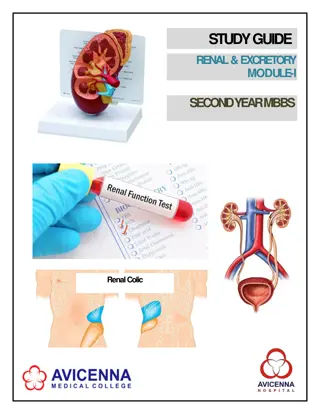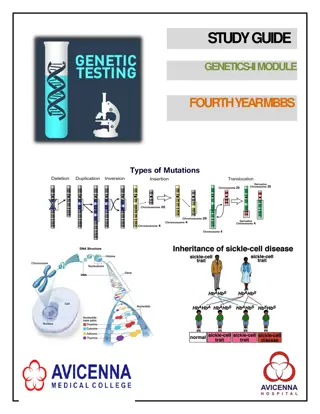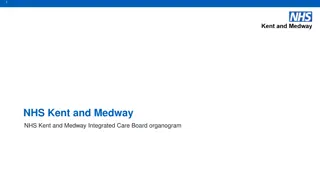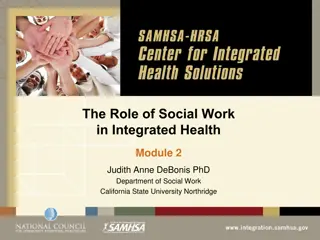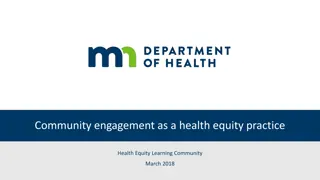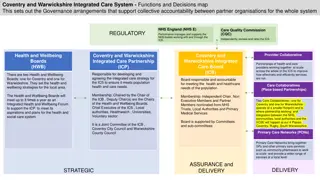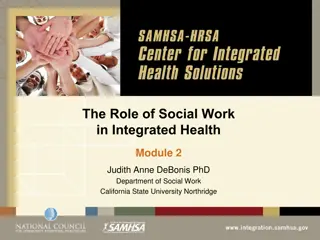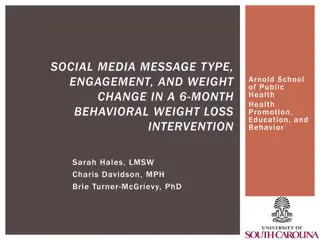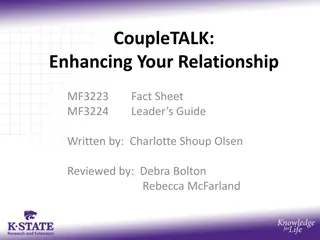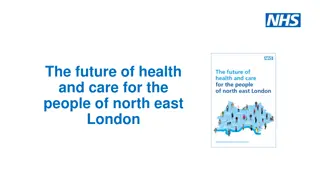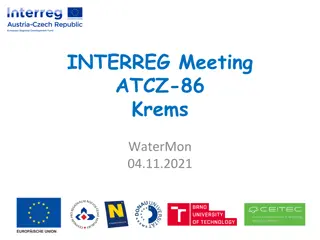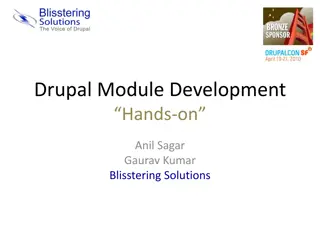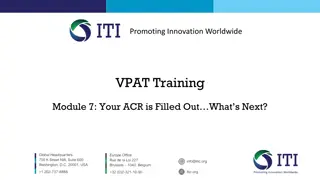Engagement and Relationship Building in Integrated Health Module 4
This module focuses on understanding the common factors model's impact on engagement and relationship building in integrated health. It emphasizes the importance of alliances in patient outcomes, explores the health coach model, and reviews patient-centered communication techniques. Effective multidisciplinary communication strategies are also discussed.
Download Presentation

Please find below an Image/Link to download the presentation.
The content on the website is provided AS IS for your information and personal use only. It may not be sold, licensed, or shared on other websites without obtaining consent from the author. Download presentation by click this link. If you encounter any issues during the download, it is possible that the publisher has removed the file from their server.
E N D
Presentation Transcript
Engagement and Relationship Building in Integrated Health Module 4 Judith Anne DeBonis PhD Department of Social Work California State University Northridge
Module 4 Engagement and Relationship Building in Integrated Health By the end of this module students will: Understand the impact of the common factors model on engagement and relationship building Know the importance of the alliance as a contributor to patient health outcomes Examine how a health coach model can provide a framework for IH Review patient-centered communication techniques to enhance engagement (listening, asking questions, etc.) Examine strategies for effective multidisciplinary communication
Relationship: The Heart of Helping People1 In 1979, Helen Harris Perlman, a social worker at the Chicago School, wrote: meaningful relationship and good communication are highly valued in society but there has been short shrift given to the recognition of the uses of relationship in the human services the phenomenon we call relationship is a catalyst, an enabling dynamism in the support, nurture, and freeing of people s energies and motivations toward problem solving and the use of help what is needed, if we are serious about helping people, is to raise this experience called relationship to our conscious and careful consideration in order to be able to use it in competent and responsible ways in the best interest of those we serve
What makes treatment effective? Questions have continued Worked to define the common factors believed to impact the effectiveness of treatment. These factors, which are shared by all treatment approaches, are not specific to any one treatment approach or model. The factors are considered to add to the overall effectiveness---above specific treatment effect. 2 In 2008, the Common Factors Model, a pantheorectical framework :
Common Factors: A Brief History2 1936: Saul Rosenweig: Attempted to identify elements that made various treatments effective. 1940: American Orthopsychiatric Society: Identified 4 similarities present in effective treatments Shared objectives Ensure relationship is central Place responsibility for choice on the client Enlarge client s understanding of self 1953: Heine: Therapist more important than theory and technique 1955: Hoch: Identified 2 common factors (rapport building and trying to influence patients) 1957: Rogers: Therapeutic variables ( unconditional positive regard ) sufficient for client change 1967: Truax & Carkhuff: therapist create conditions of empathy, respect, and genuineness which impact outcomes
Current Perspectives on Common Factors...3 The study of the effectiveness of Common Factors in treatment emphasizes the need to use client perceptions as the guiding force for the direction of the therapeutic endeavor It focuses attention on the importance of: Diversity of clients Common Factors Paradox How can knowledge about the processes of change, manualized treatment or evidence based treatments be implemented with fidelity and still capitalize on the important common factors that need to be individualized? Relationship and Alliance Including the client s perception What are the benefits and challenges of moving toward client-directed, outcome-informed approaches to tailor treatment to each unique situation based on client feedback? Current theories about change process
Alliance3 as an important common factor The idea of the therapeutic alliance shifted the effectiveness focus from therapist-provided treatment to what happened in the therapist-client collaboration Positive alliance is one of the best predictors of outcome To the degree that the therapy fits with the client s view of desired goals, activities, and therapist/client connection, the chance of positive outcome increases. The amount of change attributable to the alliance is about 7 times that of a specific technique The relationship between the therapist and the client produces change, and is not just a reflection of beneficial results
Alliance continued 3.... Client perceptions of the relationship are the most consistent predictors of improvement Suggests a need for an emphasis on tailoring treatment to the client s perceptions of a positive alliance. Requires attention to and respect for the client s goals A call for therapists to place client goals at the forefront, in an effort to ensure: 1. A strong alliance 2. Positive client engagement 3. Successful outcome
When treatment is not effectivefocus on the alliance3 Duncan and Miller (2008) provide tips for increasing one s therapeutic effectiveness when the desired change does not occur: 1. Immediate client-feedback within the session: Client/therapist develop and use of a scale to measure and use findings to increase understanding about the alliance and possible directions for improvement: 2. Therapist and client may implement a change: Incorporate other aspects of the client s support system, use a team or other professional, use a different approach, supplement with a support group, etc. 3. Frank discussion about referral and other available options
Building AllianceReview of Skills You Already Know and Use
Health Coaches Work Collaboratively with Teams4 A Health Coach Model Can Offer Value Across the Health Continuum The Origins of the Term Coaching 5 Since 1830, first used at Oxford to refer to a tutor who carries a student through an exam. Coaching helps people to: Think more deeply Tap into their own inner resources to take action Meet a challenge and enhance performance Today coaching is applied broadly to sports, health, education, psychology, organization and leadership theories. Learning is at the heart of coaching6
How is Coaching Defined Today?7 Is Is Not Coaching is a process that Coaching is not managing (Managing is making sure people do what they know how to do) Coaching is not training (Training is teaching people to do what they don t know) Coaching is not mentoring (Mentoring is showing people how the people who are really good at doing something do it) helps identify the skills and capabilities that are within a person, supporting the person to use these strengths to become the best possible.
How Coaching Works A Short Movie Group questions about the film What does the film tell us about the role of the coach? What is the role of the person being coached? How does this depiction fit with what you see as your role? Considering an Integrated Health frame, how well does the coach role align with those values, goals? http://www.youtube.com/watch?v=UY75MQte4RU&feature=related
Essentials of Coaching6 Three Essential Techniques that are Useful for Integrated Health The Big 3 Being an active and engaged listener Asking powerful questions Using suggestions and discoveries rather than directions Coaching is a conversation that can move a person forward
1 Essentials of Coaching6 Active Engaged Listening This is listening that is focused and picks up on feelings as well as words. Through active listening the coach is able to shine a light on what is said, allowing the person to really hear. By acknowledging the efforts that the person is making, the coach encourages a deeper and expansive thinking around a situation or problem. This can empower the person to engage more fully.
2 Essentials of Coaching6 (Cont d) Asking Powerful Questions By asking the right question, new ideas can be generated and different thinking can be triggered what might happen if you do nothing? Hmm, I hadn t considered that! The more the person talks, the more discoveries can be made.
3 Essentials of Coaching6 (Cont d 2) Using Suggestions and Discoveries Rather Than Directions Working with another person to discover suggestions for how to approach a situation or problem offers ideas to consider that are not direct orders. The ideas generated can help the person to examine things in a different light, to explore, to have new insights. There can be huge payoffs. Even if the discovery is not followed immediately, it might result in an insight and change in an unexpected way. (Remember that change can occur as a result of many different things not just as a result of our interaction with the person).
Learning from Sales How to Shine the Light on Others8 Engagement is Essential Dialogue is only possible when the person is engaged in the process. What does the person feel? What is their top of mind awareness? What do they need? What are their hot buttons? Beginning The Engagement
How Engaged are the Consumers you work with? 8 Starting the Dialogue Write down a variety of questions leading questions to tie into the benefits of your services. Practice asking these (family, peers, colleagues) to get feedback about how you are perceived by others (your tone and how you come across). When I say diet what s the one word that comes to mind? What is the value of knowing your participants hot buttons? If you don t know, how can you find out? What is the difference between a dialogue and a monologue?
FOUR Key Communication Strategies O.A.R.S.9 O=Open-Ended Questions (Encourages more than a yes no answer) A=Affirm (Acknowledges experiences) R=Reflective Listening (Demonstrates a desire to understand) S=Summarize (Reinforces and links ideas and feelings)
Open-Ended Questions9 Open-ended questions can transform the interaction Open questions gather broad descriptive information Try it Out Identify open and closed questions Ask different types of questions Discuss the results Facilitate dialogue Require more of a response than a simple yes or no Often start with words like how or what or tell me about or describe Examples What concerns you most about What is worrying you most today What exactly happens when Tell me more about Usually go from general to specific Convey that our agenda is about the person
Affirm9 Though the easiest, the most neglected Must be done sincerely Try it Out Offer an affirmation to the person on your right and then on your left. Offer a second affirmation when possible. How can we give an affirmation to a person that we don t know well? Supports and promotes self- efficacy Acknowledges the difficulties the person has experienced Validates the person s experience and feelings Emphasizes past experiences that demonstrate strength and success to prevent discouragement Examples Glad to hear how well you re doing. You have such good ideas! I m glad to talk with you today!
Reflective Listening9 Positive proof that you ve been listening parrots repeat but don t reflect Try it Out Make statements that might be said by a patient and come up with a reflective response. The group can help. Pair up. One person brings up an issue while the other can only respond with reflective statements. Difficult? Reflective listening begins with a way of thinking It includes an interest in what the person has to say and a desire to truly understand how the person sees things It is essentially hypothesis testing Examples: Repeating simplest Rephrasing substitutes synonyms Paraphrasing major restatement Reflection of feeling deepest What you think a person means may not be what they mean
Summarize9 Summaries reinforce what has been said, show that you have been listening carefully Summaries can link together the person s feelings of ambivalence and promote perception of discrepancy Prepare the person to move on Examples: A transitional summary includes the pros, the cons and an invitation to continue to talk on the one hand on the other hand what else A major summary either at the end or a significant point in the conversation Let me see if I understand what you ve told me so far... Was there anything I missed ?.. Try it Out Pair up Talk for 5 minutes Give a transitional summary Talk 2 minutes more Give a major summary
Activity Practicing Good Communication Exercise OARS illustration Three Students to a Group One will tell their story. The second will respond using only open ended questions, affirmations, reflective listening or summarizing at key points. The third student will take notes about which types of responses were used. Discuss how this felt. How difficult was it to not give direction or advice?
Using Suggestions and Discoveries Rather than Directions
The Spirit of Motivational Interviewing (MI)10 There s something in human nature MI Application is Limitless The techniques and approach of motivational interviewing can be effective in supporting recovery in a person with a drug or alcohol addiction, in engaging a person with a serious mental health disorder, in encouraging lifestyle changes in a person managing a chronic physical condition. that resists being coerced and told what to do. Ironically it is acknowledging the other s right and freedom not to change that sometimes makes change possible Guiding more than directing Dancing more than wrestling Listening at least as much as telling
The Spirit Makes Change Possible10 Motivational Interviewing is: Collaborative All decisions are jointly made as a partnership. Evocative Not interested in giving the person what they don t have but focuses on what the person has and what they care about. Honors the patient s autonomy and self determination Accepts that patients make choices about their lives. Clinicians can inform, advise, and warn but ultimately the patient decides what they do.
SPECIFIC Characteristics of Motivational Interviewing 10 Motivational interviewing is a conversation that has a purpose and a specific goal. Addresses and resolves ambivalence in the direction of change Sometimes in order to do this, ambivalence needs to be explored or created. MI is specific using certain helping skills in a prescribed way and attending to specific forms of speech Responds in two specific and important ways: 1. Rolls with resistance without confrontation or argument 2. Elaborates, affirms, reflects or summarizes change talk
MI builds on the work of Carl Rogers and James Prochaska10 Carl Rogers11 suggested that the ingredients that make it possible for a person to change behavior include: Being in a relationship with a practitioner who is genuine, real Experiencing an empathetic, non judgmental attitude (Unconditional Positive Regard) James Prochaska12suggested that a person s ambivalence about change had to be resolved before they could take action Consider whether the suggestions of Rogers and Prochaska are being applied in healthcare settings that you know. Give examples of specific types of changes that patients are encouraged to make and how these suggestions would enhance patient activation and motivation. What barriers might interfere with the MI approach?
Combining the two ideas10 Offering accurate empathy and helping the person to resolve ambivalence can DECREASE Resistance = verbally defending the status quo, it s the person s way of telling you they are not with you, need more time or don t agree AND INCREASE Change Talk = verbally arguing for change Using Motivational Interviewing means a focus on the person s Desire, Ability, Reasons, Need will increase Commitment lead to Change
Promoting a Style that Strategically Supports the Person10 Guiding a guide can help you find your way I can help you to solve this for yourself Directing taking charge. It can be necessary to save lives sometimes. I know how you can solve this problem I know what you should do Following listening predominates I won t change or push you I trust your wisdom about yourself I ll let you work this out at your own pace How comfortable are you in using each of the three styles? Which do you use most often? Least often?
Using Following, Guiding, and Directing10 Being able to shift from one style to another is key Balancing the mixture can be most effective It is better to follow and contemplate a little, to support and guide, before using a directing style Guiding is probably the best choice in discussions about a person s lifestyle and behavior change, where a person s own engagement, motivation, energy and commitment are crucial In healthcare practices, the balance usually shifts toward Directing while the value of Following and Guiding are ignored Pressures to assess, prioritize, diagnose, provide, measure, promote, follow-up and reach targets are likely causes of this shift
Reflect Consider the Following Question When you are the person being helped, what style do you prefer your providers take when talking with you? Explain your choice. 1. Discuss your reaction to being followed, guided, directed. What specifically contributes to your preferences? In what way does age, generation, gender, race, and cultural or ethnic background impact your preferences? How might these factors influence the preferences of other healthcare consumers? 2.
Increasing Awareness of Common Obstacles to Communication
The RULE Acronym10 To Keep in the Spirit of Motivational Interviewing, Follow the RULE Resist the righting reflex (Our natural urge to help or correct can result in the human tendency to resist) Understand patient s motivations (Better to know the person s own reasons for change and how they might do it than tell them they should) Listen to your patient (Answers lie within the patient and to find them requires listening, asking good questions, and checking out hypotheses) Empower your patient (Explore how the person can make changes, their ideas, and the resources available. The more out loud the person is, the more they will act)
Listening13 Listening gathers information, improves the relationship with the person, and can take as little as 1-2 minutes True listening Highlights that you have only one agenda the person talking Opens the door for dialogue and a positive working relationship Silence can give time for a full response Be careful not to voice all of the roadblocks that can get in the way (warning, disagreeing, suggesting, sympathizing, reassuring etc)
Responses that are not listening9 1) 2) 3) 4) 5) 6) 7) 8) 9) 10) Reassuring, sympathizing 11) Probing, questioning, interrogating 12) Withdrawing, distracting, humoring Ordering, commanding, directing Threatening, warning Advising, giving solutions Lecturing, arguing Moralizing, preaching Judging, blaming, criticizing Praising, agreeing Name-calling, ridiculing, shaming Interpreting, diagnosing, analyzing Dr. Gordon s twelve common roadblocks to communication
Examples of roadblocks9 Ordering, commanding, directing. Don t say that. You ve got to face up to reality. Threatening, warning. You re really asking for trouble when you do that. Advising, giving solutions. What I would do is... Why don t you... Lecturing, arguing. Let s think this through... The facts are that... Moralizing, preaching. You should... You really ought to ... Judging, blaming, criticizing. It s your own fault. You re wrong. Praising, agreeing. I think you re absolutely right! That s what I would do.
Examples of roadblocks continued9 Name-calling, ridiculing, shaming. How could you do such a thing? Interpreting, diagnosing, analyzing. You don t really mean that. Do you know what your real problem is. Reassuring, sympathizing. I m sure things are going to work out all right. Don t worry. Probing, questioning, interrogating. Why? What makes you feel that way? Withdrawing, distracting, humoring. Let s talk about that some other time. I hear it s going to be a nice day tomorrow.
Activity Roadblock Illustration Role Play One person will play the role of a consumer who tells what happened when they tried to make a change in their life that they thought would help them feel healthier. The rest of the group will make statements or ask questions that illustrate one of the roadblocks. Discuss . How did each feel, sound? How did the roadblocks interfere with the process? What might the long-term impact of a roadblock be?
When faced with a roadblock most people shut down or try again to be understood generally without much success Discussion Roadblocks are sometimes called the language of unacceptance 9 Roadblocks 1-5: Contain the hidden message you re not smart enough to figure this out on your own so I ll tell you. Roadblocks 6-11: Imply that there s something wrong with you (and in the some cases such as analyzing and diagnosing, tell you what it is). Roadblock 12: The hidden message is it s not safe to talk about that or I m uncomfortable hearing that.
The Utility of Asking Good Questions14 Questions are an Important Component of the Entire Treatment Process 1-Engagement Allowing time for patients to respond to questions can strengthen the patient/provider partnership Helps patients identify their concerns and thoughts about what they are hoping to accomplish 4-Follow-Up Determine what is effective? Working? Obstacles? How/What is different? Helps to re-set priorities Adjust strategies when needed 2-Assessment Gather clinical data and information Capture patient perspectives and insights 5-Evalution Are patient goals being reached? Is the working partnership supporting the process 3-Intervention Identifying what has worked in the past, patient preferences is key Taking several extra minutes to examine a barrier identified by the patient can result in a more tailored approach that has a better chance of success 6-Next Steps What was learned from previous efforts How might this knowledge guide future change efforts?
Learning from Sales Asking Powerful Questions15 The Most Powerful Element of Selling is Asking The most engaging questions are those that haven t been heard before. The more thought provoking, the more respect is generated and the more honest the answer. What are we selling as social workers in a health environment? Asking Powerful Questions
Create Something New Generate 25 Engaging Questions Are you engaging your consumers with thought provoking questions? ??? ? ? Break into pairs or triples and generate a list of 25 questions that will engage. ? Consider different types of questions for the different phases of the treatment process.
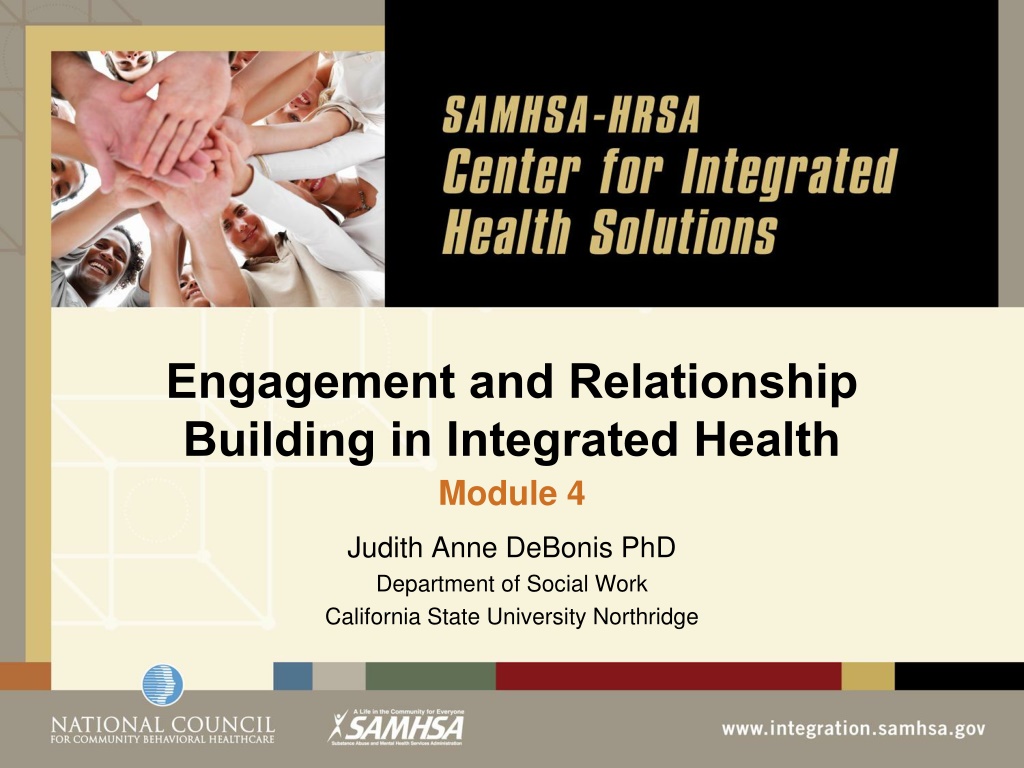

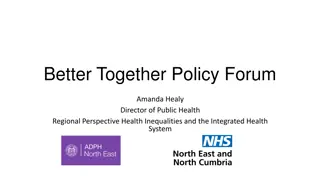
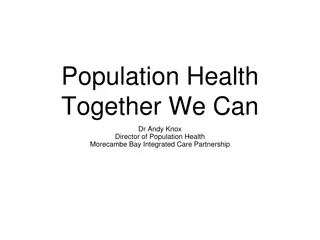


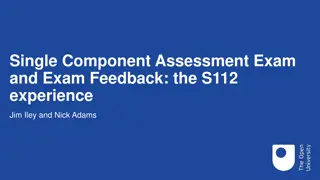
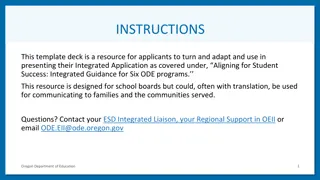
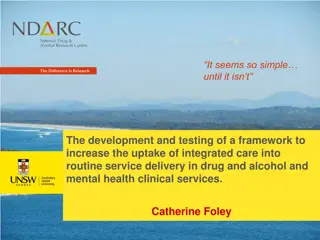
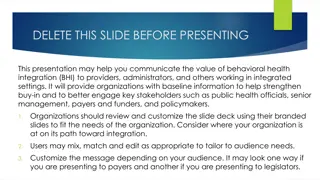





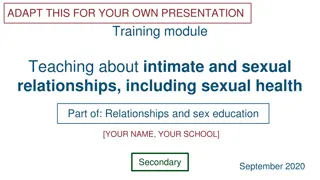
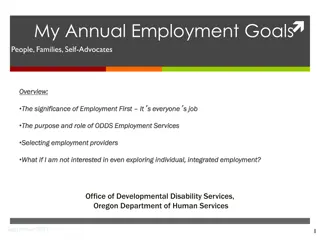

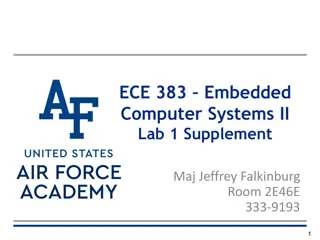
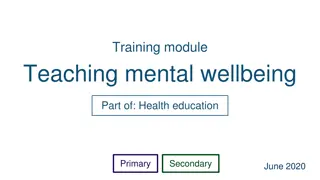
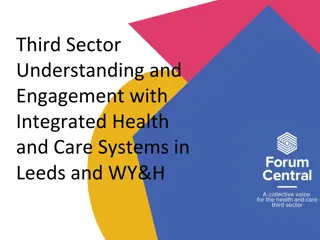
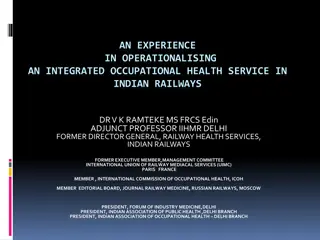
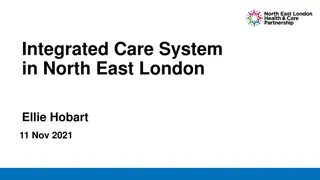

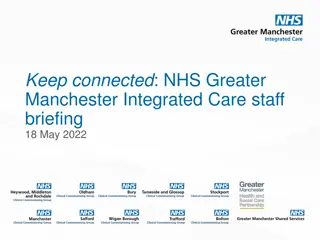

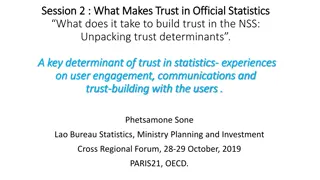

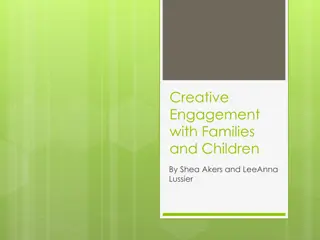
![Teaching Health and Prevention at [Your School]: Training Module for Physical Health and Mental Wellbeing](/thumb/167013/teaching-health-and-prevention-at-your-school-training-module-for-physical-health-and-mental-wellbeing.jpg)
